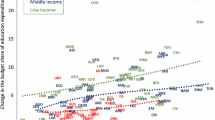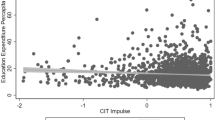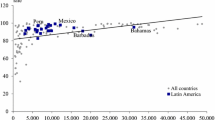Abstract
Teacher’s salaries make up a significant portion of government spending on education in most of sub-Saharan Africa. We examine the relationship between increased spending on additional teachers and education quality, as measured, respectively, by lower pupil-teacher ratios and educational attainment using South Africa as a case study. In the apartheid era, most Black South Africans were disadvantaged and their schools were poorly resourced. To deal with this issue, post-apartheid governments have, among other things, increased their spending on basic education, mainly through increases in government-employed teachers to reduce the pupil-teacher ratio. Using a reduced form production function approach, we apply a partial proportional odds model to identify heterogeneous effects of the pupil-teacher ratio at different levels of education.
Access this chapter
Tax calculation will be finalised at checkout
Purchases are for personal use only
Similar content being viewed by others
References
Adams, Don. “Defining educational quality.” Improving Educational Quality Project Publication 1 (1993).
Angrist, Joshua D., and Victor Lavy. “Using Maimonides’ rule to estimate the effect of class size on scholastic achievement.” The Quarterly Journal of Economics 114, no. 2 (1999): 533–575.
Aturupane, Harsha, Paul Glewwe, and Suzanne Wisniewski. “The impact of school quality, socioeconomic factors, and child health on students’ academic performance: Evidence from Sri Lankan primary schools.” Education Economics 21, no. 1 (2013): 2–37.
Barile, John P., Dana K. Donohue, Elizabeth R. Anthony, Andrew M. Baker, Scott R. Weaver, and Christopher C. Henrich. “Teacher–student relationship climate and school outcomes: Implications for educational policy initiatives.” Journal of Youth and Adolescence 41, no. 3 (2012): 256–267.
Behrman, Jere R. “Investment in education—Inputs and incentives.” In Handbook of development economics, vol. 5, pp. 4883–4975. Elsevier, 2010.
Bhorat, Haroon, Carlene Van der Westhuizen, and Toughedah Jacobs. “Income and non-income inequality in post-apartheid South Africa: What are the drivers and possible policy interventions?” Development Policy Research Unit DPRU Working Paper 09/138 (2009).
Bhorat, Haroon, and Morne Oosthuizen. “Determinants of Grade 12 pass rates in the post-apartheid South African schooling system.” Journal of African Economies 18, no. 4 (2009): 634–666.
Boes, Stefan, and Rainer Winkelmann. “Ordered response models.” Allgemeines Statistisches Archiv 90, no. 1 (2006): 167–181.
Case, Anne, and Angus Deaton. “School inputs and educational outcomes in South Africa.” The Quarterly Journal of Economics 114, no. 3 (1999): 1047–1084.
Dearden, Lorraine, Javier Ferri, and Costas Meghir. “The effect of school quality on educational attainment and wages.” Review of Economics and Statistics 84, no. 1 (2002): 1–20.
Department of Basic Education. “Education for all: Country Report, South Africa.” Pretoria, South Africa, (2010).
Department of Education. “A review of financing, resourcing and costs of education in public schools.” Department of Education, Pretoria, South Africa. Technical report (2003)
Glewwe, Paul, and Michael Kremer. “Schools, teachers, and education outcomes in developing countries.” Handbook of the Economics of Education 2 (2006): 945–1017.
Glewwe, Paul W., Eric A. Hanushek, Sarah D. Humpage, and Renato Ravina. “School resources and educational outcomes in developing countries: A review of the literature from 1990 to 2010.” No. w17554. National Bureau of Economic Research, 2011.
Graddy, Kathryn, and Margaret Stevens. “The impact of school inputs on student performance: An empirical study of private schools in the UK.” (2003).
Gustafsson, Martin. “Using the hierarchical linear model to understand school production in South Africa.” South African Journal of Economics 75, no. 1 (2007): 84–98.
Gustafsson, Martin. The when and how of leaving school: The policy implications of new evidence on secondary schooling in South Africa. No. 09/2011(2011).
Hanushek, Eric A. “Interpreting recent research on schooling in developing countries.” The World Bank Research Observer 10, no. 2 (1995): 227–246.
Council on Higher Education (CHE). Higher Education in the first decade of democracy. Pretoria: Council on Higher Education (2004).
Ladd, Helen, and Susanna Loeb. “The challenges of measuring school quality.” Education, Justice, and Democracy 19 (2013).
Lee, Jong–Wha, and Robert J. Barro. “Schooling quality in a cross–section of countries.” Economica 68, no. 272 (2001): 465–488.
Leibbrandt, Murray, Ingrid Woolard, and Louise de Villiers. “Methodology: Report on NIDS wave 1.” Technical Paper 1 (2009).
Levy, Brian, Robert Cameron, Ursula Hoadley, and Vinothan Naidoo. “Political transformation and education sector performance in South Africa.” The Politics of Education in Developing Countries: From Schooling to Learning. Oxford: Oxford Scholarship Online (2019): 105.
Mlachila, Mr Montfort, and Tlhalefang Moeletsi. “Struggling to make the grade: A review of the causes and consequences of the weak outcomes of South Africa’s education system.” International Monetary Fund (2019).
Moloi, M. Q., and M. Chetty. “Quality of primary school inputs in South Africa.” Policy Brief 2 (2011).
Republic of South Africa. “National norms and standards for school funding, South African School Act, 1996.” Department of Education. Technical report (1998).
Spaull, Nic. “Schooling in South Africa: How low-quality education becomes a poverty trap.” South African Child Gauge 12 (2015): 34–41.
SALDRU. National Income Dynamics Study (2010–2011), 1, Wave 1 (2012).
Taylor, Nick, Brahm Fleisch, and Jennifer Shindler. “Changes in education since 1994.” Higher Education 32 (2008): 3–5.
UNESCO Institute for Statistics. Financing education in Sub-Saharan Africa: Meeting the challenges of expansion, equity and quality. UNESCO, (2011).
Van der Berg, Servaas. “Apartheid's enduring legacy: Inequalities in education.” Journal of African Economies 16, no. 5 (2007): 849–880.
Van der Berg, Servaas, and Eldridge Moses. “Inertia in South African education quality: evidence from SACMEQ II and III.” Policy Brief, Department of Economics, University of Stellenbosch (2011).
Williams, Richard. “Generalized ordered logit/partial proportional odds models for ordinal dependent variables.” The Stata Journal 6, no. 1 (2006): 58–82.
Williams, Richard. “Understanding and interpreting generalized ordered logit models.” The Journal of Mathematical Sociology 40, no. 1 (2016): 7–20.
Wößmann, Ludger. “Schooling resources, educational institutions and student performance: the international evidence.” Oxford Bulletin of Economics and Statistics 65, no. 2 (2003): 117–170.
Yamauchi, Futoshi. “School quality, clustering and government subsidy in post-apartheid South Africa.” Economics of Education Review 30, no. 1 (2011): 146–156.
Author information
Authors and Affiliations
Corresponding author
Editor information
Editors and Affiliations
Rights and permissions
Copyright information
© 2022 The Author(s), under exclusive license to Springer Nature Switzerland AG
About this chapter
Cite this chapter
Kimani, M.E. (2022). Does Increased Government Spending on Additional Teachers Improve Education Quality?. In: Wamboye, E.F., Fayissa, B. (eds) The Palgrave Handbook of Africa’s Economic Sectors. Palgrave Macmillan, Cham. https://doi.org/10.1007/978-3-030-75556-0_15
Download citation
DOI: https://doi.org/10.1007/978-3-030-75556-0_15
Published:
Publisher Name: Palgrave Macmillan, Cham
Print ISBN: 978-3-030-75555-3
Online ISBN: 978-3-030-75556-0
eBook Packages: Economics and FinanceEconomics and Finance (R0)




